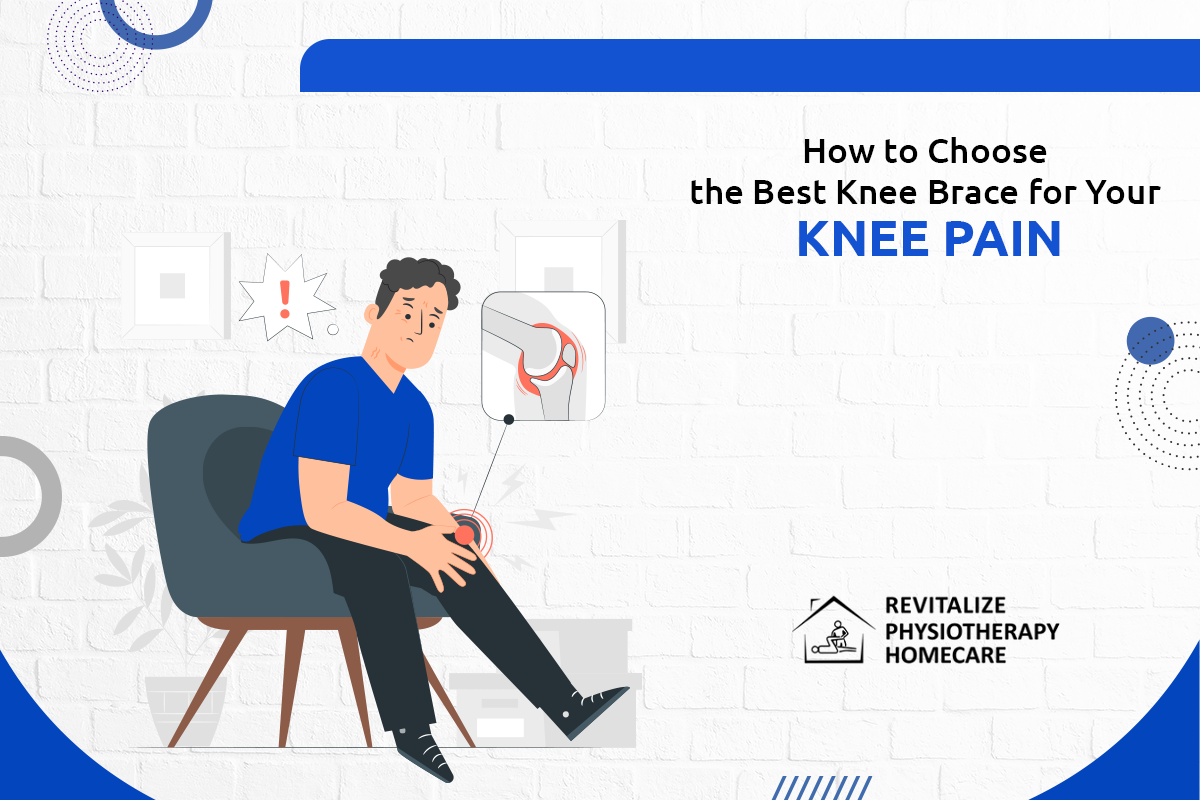How to Choose the Best Knee Brace for Your Knee Pain
Knee pain can be a debilitating condition that affects people of all ages and activity levels. Whether you are an athlete or simply trying to maintain an active lifestyle, knee pain can impact your ability to perform daily activities and pursue your favorite hobbies.
Fortunately, knee braces can be an effective way to manage knee pain and improve joint stability. However, with so many options available, choosing the best knee brace for your knee pain can be overwhelming.
In this insightful blog, we will explore the factors to consider when choosing a knee brace. By understanding these factors, you can choose the best knee brace to help you manage your knee pain and maintain an active lifestyle.
First, let us have a look at different types of knee braces and when to wear them!
Different types of knee braces:
There are various types of knee braces available, each designed to address specific types of knee pain and provide varying levels of support.
Some of the most common types of knee braces include:
1. Knee sleeves:
Knee sleeves are typically made of neoprene and provide compression to the knee joint. They are ideal for individuals with mild knee pain or for providing support during low-impact activities.
2. Knee supports:
Knee supports are designed to provide additional support to the knee joint and are often used for individuals with moderate knee pain. They typically have adjustable straps or hinges to provide a customizable level of support.
3. Knee stabilizers:
Knee stabilizers are similar to knee supports but are designed to provide more rigid support to the knee joint. They are ideal for individuals with moderate to severe knee pain or for use during high-impact activities.
4. Knee immobilizers:
Knee immobilizers are designed to restrict movement of the knee joint entirely. They are typically used after surgery or during recovery from a knee injury.
5. Knee braces for specific conditions:
There are also knee braces designed to address specific knee conditions such as patella tracking disorder or osteoarthritis. These braces are often custom-fitted and provide targeted support to the affected area.
It's important to choose a knee brace that is appropriate for your specific needs and level of knee pain. Consult with a healthcare professional or physical therapist to determine which type of knee brace is best suited for your condition and activity level.
When to wear knee braces?
Knee braces are designed to provide support and stability to the knee joint, and can be worn for a variety of reasons.
Here are some common scenarios in which a knee brace may be recommended:
1. Knee injury:
If you have sustained a knee injury, such as a ligament sprain or meniscus tear, wearing a knee brace can provide support and stability to the joint as it heals.
2. Knee pain:
If you experience chronic knee pain, a knee brace can help alleviate discomfort and improve joint function. Knee braces can also be worn during activities that exacerbate knee pain, such as running or jumping.
3. Knee osteoarthritis:
Individuals with knee osteoarthritis may benefit from wearing a knee brace to help reduce pain and improve joint function.
4. Preventative measures:
Athletes or individuals who engage in high-impact activities may wear a knee brace as a preventative measure to reduce the risk of knee injuries.
5. Post-surgery:
After knee surgery, such as ACL reconstruction, a knee brace may be recommended to provide support and stability to the joint as it heals.
Choose the best knee brace for your knee pain:
The right knee brace will help relieve knee pain and increase stability when you do physical activity. These are some tips that will help you select the right knee brace to relieve your knee pain.
1. Talk to your doctor or physiotherapist
If you are experiencing knee pain and are considering wearing a knee brace, it's important to talk to a doctor or Brampton Physiotherapist to determine which brace is best suited for your needs. They can accurately diagnose the underlying cause of your knee pain and determine whether a knee brace is an appropriate treatment option. Based on your diagnosis, they can recommend the best type of knee brace for your specific condition and activity level. They can also provide guidance on how to properly wear and adjust the brace for maximum benefit. They even monitor your progress and make adjustments to your treatment plan as necessary. Talking to a healthcare professional can help ensure that you are using the right type of knee brace for your needs, which can help improve the effectiveness of the treatment and speed up your recovery.
2. Decide the type of knee brace that you require
Choosing the right type of knee brace can be crucial in managing knee pain and preventing further injury. After consulting with a doctor or physiotherapist it can get easier for you to determine which type of knee brace is best suited for your needs. While choosing one, specific injury, activity level, and budget are factors that you must take into account. They can provide guidance on how to properly wear and adjust the brace for maximum benefit. Choosing the right type of knee brace can help improve the effectiveness of the treatment and speed up your recovery.
3. Think about the support you require
When choosing a knee brace for knee pain, it's important to think about the level of support that you require. The type of support that you need will depend on the severity of your injury and the level of activity that you engage in.
If you have a ligament injury or have undergone surgery, you may require a knee brace that provides stabilization to the joint. A hinged or rigid brace can help prevent further injury and provide support during physical activity.
4. Select the right size
Selecting the right size of knee brace is essential to ensure proper support and comfort for your knee pain. It's important to measure your knee and refer to the sizing chart provided by the manufacturer. Trying on the brace before purchasing it, considering adjustability, and seeking professional guidance can also be helpful. A proper fit can ensure proper support, reduce discomfort, and increase your overall satisfaction with the knee brace.
5. High-quality materials are important
Choosing a knee brace made of high-quality materials is crucial for ensuring its effectiveness and durability. High-quality materials can provide adequate support, comfort, and breathability. For example, neoprene is a common material used in knee braces, known for its flexibility and heat retention properties. However, it may not be suitable for those with sensitive skin or allergies. Other materials like polyester, nylon, or spandex may be more suitable for those with sensitive skin. Additionally, high-quality materials can help prevent skin irritation, friction, and odor, which are common issues associated with knee braces. It's important to consider the quality of materials when selecting a knee brace to ensure its effectiveness and comfort for your knee pain.
6. Take into account the level of activity
Taking the level of your activity into account is crucial when choosing the best knee brace for your knee pain. If you have a more active lifestyle, you may need a knee brace with stronger support and stability to protect your knee during high-impact activities. On the other hand, if you have a more sedentary lifestyle, you may need a knee brace that provides lighter support and comfort. Additionally, some knee braces are designed specifically for certain activities, such as running or weightlifting, and may provide targeted support in the areas where you need it the most. Considering your level of activity can help you choose a knee brace that provides the right level of support and comfort for your needs.
7. Look out for adjustable straps
Adjustable straps are an important feature to look for when selecting a knee brace for your knee pain. They allow you to customize the fit of the brace to your individual needs, providing optimal support and comfort. With adjustable straps, you can tighten or loosen the brace as necessary to ensure a secure and comfortable fit. This can also be helpful if you experience swelling in your knee, as you can adjust the brace to accommodate changes in your knee size. Additionally, adjustable straps can allow for more freedom of movement, making the brace more comfortable to wear during activities.
Conclusion:
Choosing the best knee brace for your knee pain requires careful consideration of several factors. These factors will help you choose the best knee brace for your knee pain.
It's important to consult with a Knee Replacement Clinic in Brampton or from the professional you have got your Knee Pain Treatment in Brampton before selecting a knee brace, as they can provide guidance on which type of brace is best suited to your specific needs.
For the best Knee Replacement Physiotherapy in Brampton, consider consulting experts of Revitalize now!
We also offer the best inhome physiotherapy to treat you well!




